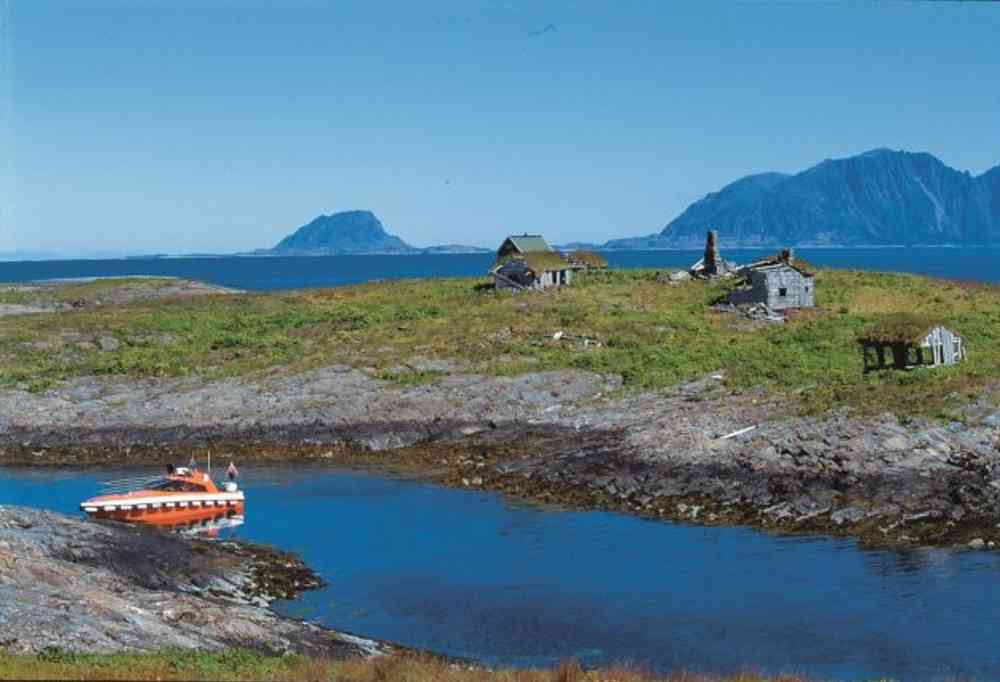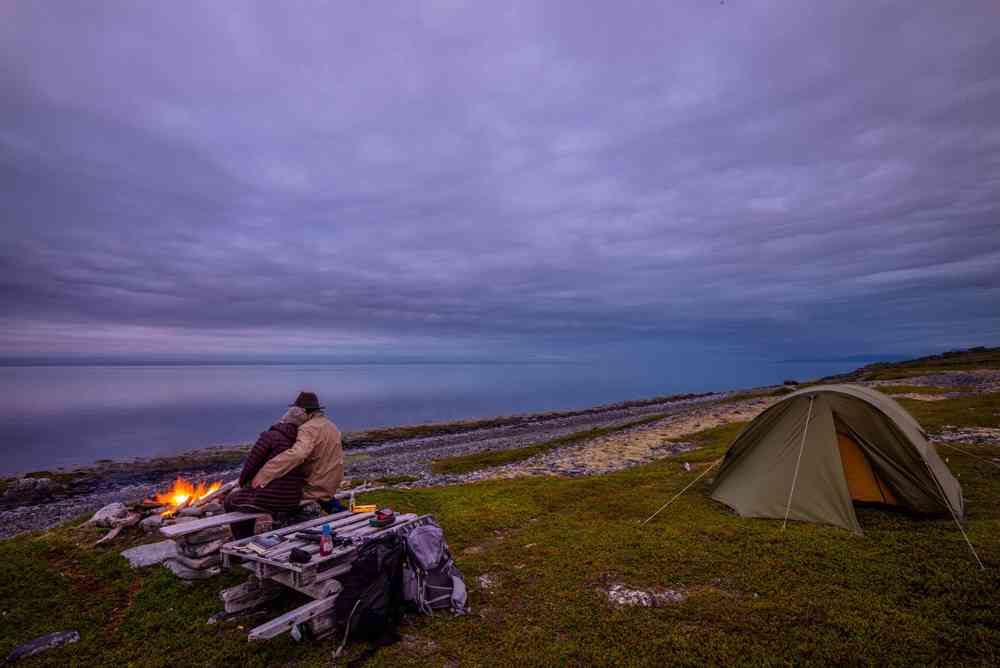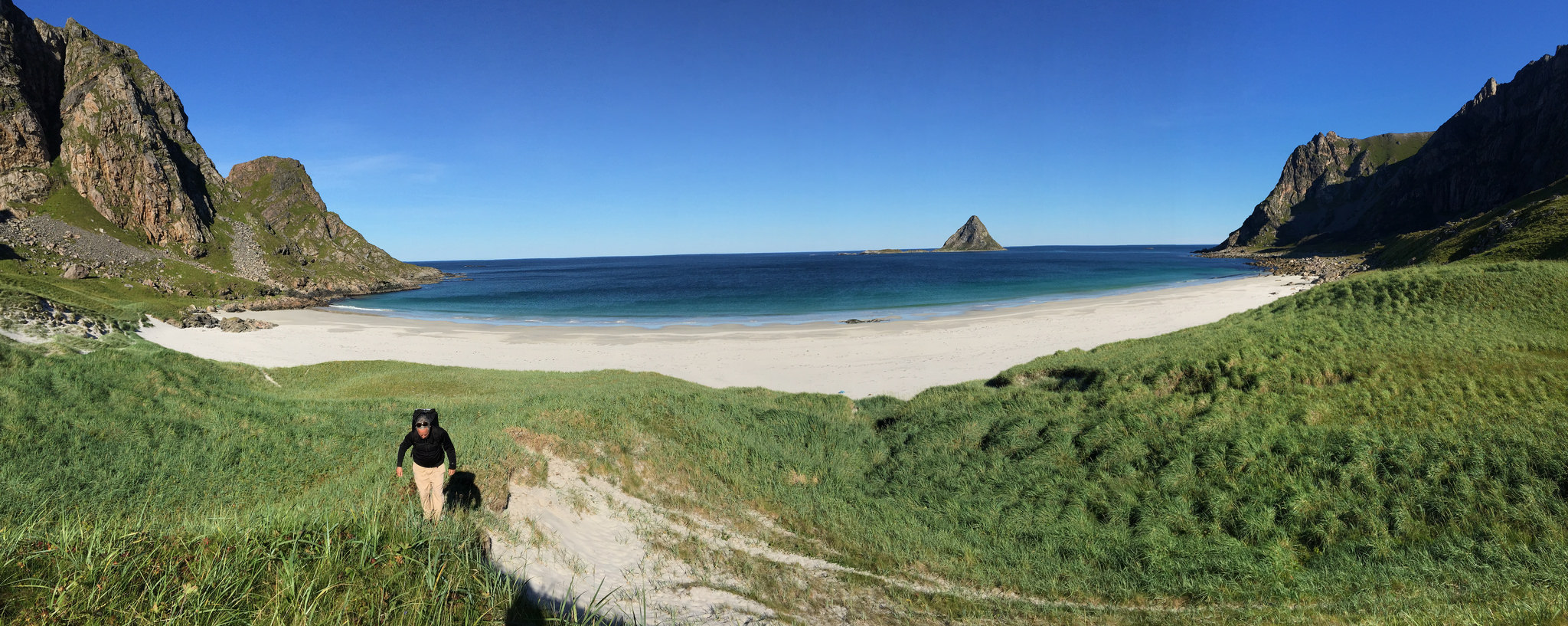Only Canada exceeds the 100 915 kilometres of coast in Norway, which is longer than the shores of such countries as the USA, China and Brazil.
This is because of the numerous offshore islands great and small which fringe the Norwegian coast, and the fjords cut deeply into the land.
Human impact
With so much coastline, it might be thought that Norway’s 5.2 million inhabitants would have plenty of unsullied nature to enjoy. But that is not the case.

The Thousand Islands country along the Helgeland coast of Nordland county offers good opportunities for life outdoors. Many traces of earlier settlements can be found here. Photo: Olav Haugen/NCA maritime safety department.
Those parts of the shore left untouched were either too inaccessible or not worth exploiting. Today, however, many of the outlying islands have been abandoned.
All that remains where people once lived are the sites of ruined or vanished houses. Where dwellings which have been preserved, they live on as holiday homes.
Olav Haugen, editor of Den norske los (The Norwegian Pilot) in the department for maritime safety at the Norwegian Coastal Administration (NCA), has sailed the entire length of Norway.
That has taken him from the border with Russia in the far north to the Swedish frontier in the south-east in order to map the coastline.
“The fjords are less affected than out by the sea,” reports the man who has seen with his own eyes where coastal nature is least influenced by people.
“That’s because they’re further from the fishing grounds. Moreover, the mountains plunge sheer into the fjords in many places and make it too difficult to settle there.”
Untouched and accessible coastal nature
The Norwegian Environment Agency (NCA) defines an area of untouched nature as one which lies more than a kilometre from such substantial technical infrastructure as roads, railway lines, dams and big power lines.
About 44 per cent of Norway’s land surface – excluding the remote islands of Svalbard and Jan Mayen – was defined as untouched in January 2013.
Most of these areas are found in the high mountains and the inland regions. Only a small part of the coastline can be said to possess unsullied nature.
Potentially accessible stretches of the shore are calculated by Statistics Norway on the basis of terrain, roads, railways, acreage under cultivation, buildings and coast.
Those locations unaffected by technical interventions are regarded as potentially accessible for outdoor recreation. They also possess qualities related to their slopes.
Best in the north
According to Haugen, the coastline offers a number of attractive and relatively untouched areas which are also accessible to people. These are often in practice abandoned settlements.
The general rule is that the number of such locations and the density of settlement declines the further north one goes in Norway. Good opportunities for solitary enjoyment of nature can be found northwards from Bømlo on the south-west coast.
Some of the best areas listed by Haugen include the sounds and fjords surrounding Namsos in Nord-Trøndelag and the islands around Vikna in the same country.
Others are the Helgeland coast in Nordland county, the islands north of Ringvassøy in Troms county, and the chain of coastal skerries off Kirkenes in far northern Finnmark.
“If you really want to enjoy ‘untouched’ nature, then the Arctic Svalbard islands are a good option,” Haugen observes. “Distances are great, and a lot of preparation is needed, but the experiences are huge and magnificent.
“You can always sail in the waters around Svalbard during the summer months, even though ice may prevent you getting all the way round in some years.”
He has defined three top areas of Norway in terms of accessible coastal nature.
1) Bømlo to Florø
This region offers a fantastic wealth of islands for pleasure boats. They provide protection from the open sea and people can largely enjoy the scenery by themselves.
The downside is that the weather can be poor, while temperatures in the water are not always conducive to sea bathing.
2) Senja
This big island in Troms county presents landscapes which combine high mountains with numerous holms. Senja mixes southern Norway’s skerry chains with the ruggedness of Lofoten.
3) Outer Oslo Fjord and south coast to Mandal
The chain of skerries along the Skagerrak provides countless small islands, bays, smooth rock shores and places to bath, with a climate characterised by warm summers.

“Coastal landscapes are more unspoilt the further north you go,” says Olav Haugen. Photo: maritime safety department, NCA.
Seeking to safeguard scenic delights
The Norwegian Trekking Association (DNT) has picked out some examples of coastal landscapes which it believes are important for many people, and which it wants to protect from such activities as wind power developments.
These areas are:
- Stadlandet north of Bergen
- the Jæren coast south of Stavanger
- the North Cape plateau
- Sommerøy in the far north
- the outer Sogne Fjord
- the Helgeland coast of Nordland county
- Lofoten
- Vesterålen.
The Helgeland coast has also topped a poll organised by the DNT to identify the most beautiful scenic jewel on the Norwegian coast.
Such surveys are subjective, and their outcome is often a result of who has mobilised the largest number of people to vote for their own choice.
Nevertheless, this vote and the areas identified by the association as worthy of conservation give yet another indication of where the coast offers good opportunities for outdoor life.
The five areas which topped the poll, in order of support, were:
- the Helgeland coast
- Lofoten
- the south Norwegian coast
- the Sunnmøre coast around Ålesund
- Vesterålen.
The challenge is thereby to sit down with a map and plan relevant routes for your next journey of discovery. The Norgeskart app from the Norwegian Mapping Authority means that anyone can now print out maps with a quality which matches commercially available products.

Photo: Alf M Sollund.
See a video on how to print out your own route map (in Norwegian only).
Diving deep into unspoilt nature
Norway’s long coast also has plenty to offer those who like to be submerged. A number of areas have a rich underwater fauna, where people can dive in unexploited and unexplored nature.
Dense vegetation and great species diversity await the diver, with fish shoals, wrecked ships on the seabed and fertile kelp forests as just some of the experiences they can enjoy.
According to the Norwegian Diving Federation, these following locations are among the most interesting.
1) Saltstraumen near Bodø
Norway’s best-known diving site, this strait has the world’s strongest tidal current. That is the main attraction of this popular and easily accessible locality, although plenty of marine life is also on offer.
When diving in these powerful currents, practitioners must keep an eye on the tide so they know when it turns and changes strength.
See also Strait talk for a safe passage.
2) The Møre coast
The sea off Møre og Romsdal county is crystal-clear. Luxuriant kelp forests conceal much life, and many wrecks are available to explore. Frequent high winds and waves represent a downside.
3) Drøbak
This seaport on the eastern side of the Oslo Fjord is readily accessible. Although hardly natural, being a submarine defence work, the “Wall” (Muren) outside Drøbak nevertheless appears untouched each time you dive there.
Many other good options are to be found along the whole Norwegian coast, from the south coast all the way up to Finnmark county in the far north.
